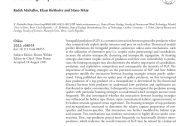Obsah
Intraguild predation (IGP) is a common interaction between generalist predators when they competitively exploit similar resources and prey on each other. Theoretical models predict limitations for intraguild predator coexistence unless some mechanisms, such as the utilization of alternative prey (i.e. trophic niche partitioning) and cannibalism, increase the relative intraspecific clustering and interspecific segregation. As hunting strategies determine trophic niches of predators and their own vulnerability to predation, the hunting strategies may also determine the relative importance of cannibalism, predation, and exploitative competition and consequently the intensity of IGP. The importance of hunting strategies on the potential outcome of IGP and how habitat properties modify the interaction between hunting strategies remain poorly understood. Using published data on spider prey of spider predators, we first investigated how predation of a top-predator on a mesopredator is determined by the functional distance between both predators to understand how predation and exploitation are distributed in spider communities. Subsequently, we investigated the predation among spiders with particular hunting strategies to understand which strategies interact most frequently. We also investigated whether the interaction between hunting strategies was influenced by habitat type (forest, open (semi)natural habitat, agroecosystem) or by habitat stratum (ground versus vegetation). The hunting strategies of top-predators and mesopredators interacted to determine the relative capture proportions of conspecifics and hetero-specifics. This interaction was further modified by habitat type and stratum. Two mechanisms can reinforce coexistence in highly diverse spider communities. First, top-predators preyed most frequently on functionally distinct meso-predators, which indicates the overall intensity of IGP may be relaxed by a balanced distribution between exploitative competition and predation. Second, cannibalism was common for top-predators with a hunting strategy of frequently preying on functionally similar mesopredators. Cannibalism may lead to self-limitation of top-predator populations and may thereby facilitate coexistence between two predator species.



